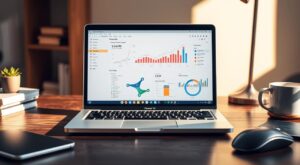
Data Analytics vs Data Analysis Explained
In today’s data-driven world, companies rely on two crucial processes to derive insights from vast amounts of information: data analytics and data analysis. Although these terms are often used interchangeably, they serve different purposes and roles in managing and interpreting data. Understanding their differences and applications is essential for businesses aiming to leverage data for strategic decision-making and growth.
Table of Contents
What is Data Analytics?
Data analytics refers to the comprehensive process of collecting, processing, and analyzing data to uncover patterns, trends, and correlations that aid decision-making. It is a broad field encompassing various methods and techniques, including predictive analytics, machine learning, and statistical modeling. The goal of data analytics is not only to interpret past data but also to make predictions about future outcomes.
According to BMC Software, data analytics involves a systematic approach where data is gathered from multiple sources, cleaned, and analyzed to extract actionable insights. It uses sophisticated algorithms and models to guide decisions in sectors such as marketing, healthcare, and finance(BMC).
Types of Data Analytics
- Descriptive Analytics – Summarizes past data to identify patterns and trends.
- Diagnostic Analytics – Investigates why certain events happened by finding relationships in historical data.
- Predictive Analytics – Uses past data to forecast future events, trends, or behaviors.
- Prescriptive Analytics – Recommends actions by analyzing both historical data and predictions.
These types of analytics help businesses optimize operations, increase efficiency, and gain a competitive edge by making data-driven decisions.
What is Data Analysis?
On the other hand, data analysis is a subset of data analytics that involves examining and interpreting specific datasets to answer particular questions. It is the process of cleaning, transforming, and modeling data to discover useful information that supports decision-making.
While data analytics covers a broader scope, data analysis focuses on the nitty-gritty of handling and inspecting data. For example, a business may use data analysis to evaluate the effectiveness of a recent marketing campaign or to determine why sales dropped in a particular quarter (QuestionPro).
Types of Data Analysis Techniques
- Text Analysis – Extracts meaningful patterns from textual data.
- Statistical Analysis – Focuses on understanding trends through numerical data.
- Diagnostic Analysis – Looks for the cause of an event or trend.
- Predictive Analysis – Forecasts future events based on historical data.
Key Differences Between Data Analytics and Data Analysis
The primary distinction between data analytics and data analysis is their scope and purpose. Data analytics encompasses a wide range of activities that involve using both historical and real-time data to drive strategic business decisions. In contrast, data analysis focuses more on analyzing specific datasets to answer predefined questions or solve targeted problems.
For example, if a business wants to predict future customer behaviors, they would employ predictive analytics, which is a part of the broader data analytics process. However, if they want to understand why their sales dipped last quarter, they would perform a diagnostic analysis, which is a type of data analysis (BMC)(QuestionPro).
Applications of Data Analytics in Business
Data analytics is critical for businesses aiming to optimize processes, increase revenue, and enhance customer experiences. Here are some common applications:
- Marketing Optimization: By analyzing customer behavior and market trends, businesses can tailor marketing campaigns for greater effectiveness.
- Risk Management: Financial institutions use data analytics to predict and mitigate risks, from loan defaults to stock market fluctuations.
- Operational Efficiency: Companies can analyze internal processes to identify inefficiencies and make improvements in supply chain management, production, and customer service(BMC).
For instance, a retail company may use predictive analytics to forecast demand and manage inventory, while a healthcare provider could use it to predict patient outcomes and allocate resources accordingly.
Applications of Data Analysis in Business
While data analytics provides a comprehensive approach to decision-making, data analysis offers more targeted insights, which can be crucial for solving specific problems. Some key applications include:
- Financial Reporting: Businesses rely on data analysis to create accurate financial statements and assess profitability over time.
- Customer Segmentation: Companies analyze customer data to divide their audience into different segments based on behavior, preferences, or demographics, improving marketing strategies.
- Sales Analysis: Data analysis helps businesses understand why sales are fluctuating by investigating customer behavior, market conditions, and operational challenges(QuestionPro).
Tools for Data Analytics vs Data Analysis
The tools used for data analytics are generally more complex and capable of handling large datasets. They include platforms like Tableau, Power BI, and Python for complex statistical modeling and machine learning. These tools offer advanced capabilities for visualizing data and forecasting trends.
In contrast, data analysis tools are often simpler and focused on specific datasets. Tools like Excel, SQL, and SPSS are frequently used to perform statistical analysis and basic reporting tasks (Bay Atlantic Univ.).
The Role of Data Science in Data Analytics and Data Analysis
Data science plays a crucial role in both data analytics and data analysis by providing the methods and algorithms needed to process and interpret data. Data scientists build models, clean data, and create algorithms that power both fields, helping businesses extract valuable insights from large datasets (BMC).
Conclusion and Final Thoughts
In summary, data analytics and data analysis are closely related but serve different purposes. Data analytics is a broad, systematic process of analyzing vast amounts of data to uncover trends and drive decisions, while data analysis focuses on interpreting specific datasets to solve particular problems. Together, these fields empower businesses to make informed decisions, improve operations, and stay ahead of the competition in a data-driven world.
FAQs
- Is data analysis the same as data analytics?
- No, data analysis is a subset of data analytics. Data analysis involves specific techniques for interpreting datasets, whereas data analytics covers a broader scope including collection, processing, and forecasting.
- What are the benefits of data analytics for businesses?
- It enables businesses to predict trends, optimize operations, enhance customer satisfaction, and reduce risks.
- Which is more important: data analysis or data analytics?
- Both are important and complementary. Data analysis helps in understanding past trends, while data analytics uses those insights for future predictions and strategic decisions.
External Links:
- Data Analytics for Business Decisions – BMC Blog
- Applications of Data Analytics in Business – QuestionPro
- How Data Analytics Drives Business Success – Bay Atlantic University
By integrating data analytics and data analysis, businesses can make better data-driven decisions and stay competitive in today’s market. The proper use of these techniques leads to insights that drive efficiency, improve customer satisfaction, and promote long-term growth.


